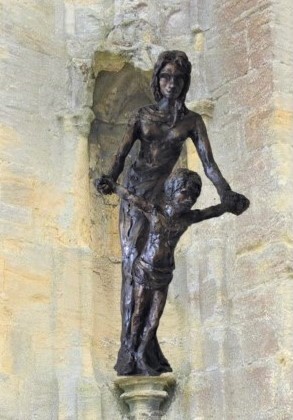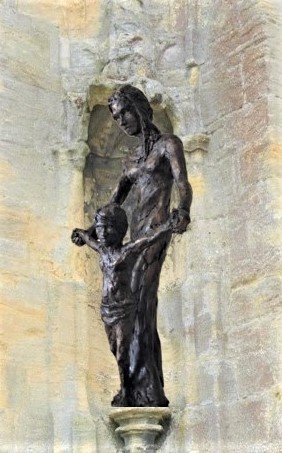Objective
My aim in these sculptures for the beautiful church of St. John Baptist in Cirencester, is to make a statement about the relevance that St. John the Baptist and the Virgin Mary have within the context of contemporary Christianity. I also wish to affirm the understanding (expressed in the brief) that the Parish Church stands at the spiritual heart of the community. In doing so, I wish to produce contemporary works that are visually interesting, whilst taking care that they do not jar with the ancient structure of the church. The sculpture should appear to be a natural part of that structure, to which they would be complementary.
The sculpture of John the Baptist:
At first, I saw this charismatic figure from the wilderness as the easier of the two pieces. I envisaged him brandishing the cross with which he is frequently represented in religious icons; a harsh figure, last of the Old Testament prophets who brought a message of destruction as the consequence of man's sin. He would signify a contrast between the Old and New Testaments, between which he formed a bridge. The cross he brandished would prefigure the crucifixion, and link him to the sculpture of the Virgin and Child.
With the passage of time, I felt that although the image could be an impressive one, I was finding it difficult to relate personally to this figure of John, and I expressed my difficulty to Cirencester's vicar, Canon Morris. In discussion, he told me that he had seen a picture of the Baptist with piercing eyes which looked through the observer, and said that he saw this as signifying that God was looking through John; that John was not important to himself, but saw himself as an intermediary. Subsequently two members of the congregation pointed out the John Baptist window, depicting the Baptist holding a lamb, the only image I have seen of him doing so as a man (normally such images show him as a child), and it was suggested that the lamb might have been included because of the importance of the wool trade to the town.
Following these conversations, I rethought my representation, and John now holds out a lamb – the Lamb of God – over the town and over the people into which he is looking. For me, this is a more relevant link to the New Testament, and I am happy that it also refers back to Cirencester's past, and its present within a farmed countryside. As with my representation of Andrew, the Fisher of Men for Plymouth, I believe that linking the religious and lay contexts of a location is important in bringing the whole community together; and I am minded of the Eucharist I attended on one of my visits to Cirencester, when the door of the church was left wide open, and I felt strongly that it symbolised the way the church invited and embraced the town.
The sculpture of the Virgin and Child:
It seems to me that representations of Mary inevitably pose some problems within the Protestant tradition. Her role as a mediator between man and God, once so important within the Roman Catholic church, raises difficulties. Similarly, the once significant and schismatic distinction between the titles of Mother of God and Mother of Christ which led to her being viewed as “The Queen of Heaven” have evaporated, and make the traditional crowned image, still to be seen occasionally, remote. At the same time, a simple image of a mother and child can easily become one that might be any mother with any child, or at worst be sentimentalized.
In order to address these problems, I decided to present the Virgin holding a standing Christ-child by both hands, as he leans out of the niche in a position typical of a child's curiosity and fearlessness, whilst at the same time being suggestive of his crucifixion. As Mary holds him, the sculpture will be both Madonna and Child, and Pieta, looking beyond Christ's childhood to a future where Mary would have to participate in his suffering and bear his body after the descent from the cross. The sculpture would have the timeless relevance of depicting the important, if difficult fact, that the way of Christ is the way of the cross.
Both sculptures will bear witness to
the centrality of Christ, and the importance of the Incarnation.
The process
Initially, I produce very basic sketches, both in order to formulate my ideas, and for presentation to a foundry for rough estimates of costs. These were drawn with a ball-pen.
Since the Virgin and Child necessitated the juxtaposition of two figures, I then produced a small rough wax sketch, in order better to work out how the two figures might relate three-dimensionally.
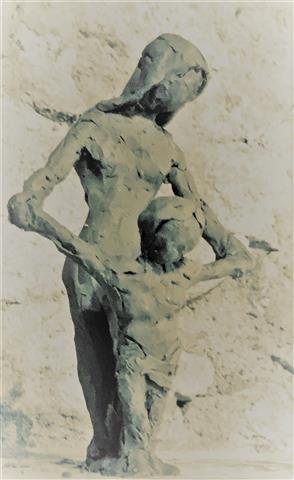
This was then followed by two more detailed pencil sketches, derived from this.
At this point, I was happy to produce clay maquettes (detailed scale models) of both Virgin and Child and St. John, which I then cast in bronze resin, which are shown at the top of this page, and which are now displayed in the church. (February 2020)
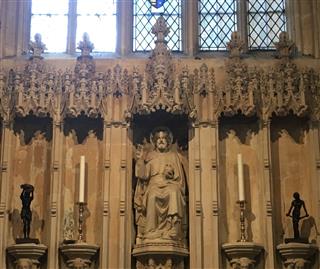
As I move on to the full size works, all stages of the procedure will be presented on this web-page, through to final installation.
24th March
I have now been in France for nearly a fortnight , where movement has been very restricted owing to Covid 19. As our French home is in a remote hamlet in the Pyrenees, we are fortunate not really to have felt much more isolated than normal, and we are surrounded by the beauty of the mountains into which we can escape. Owing to the suspension of church services in England, and the announcement that some churches would live-stream, I checked the John Baptist website, and since last Sunday have been joining the church in worship, and valuing Canon Graham Morris's wonderful efforts to continue to relate to the congregation in these difficult times. I now feel, in a very real, and unexpected sense, that I have become a part of the Cirencester church community; especially so, when the maquette of Mary and the boy Jesus were placed on the altar during the morning service on Mothering Sunday, and on the steps in front of another altar for compline. Thank you, Graham!
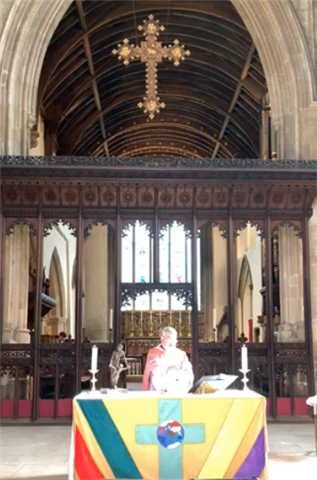
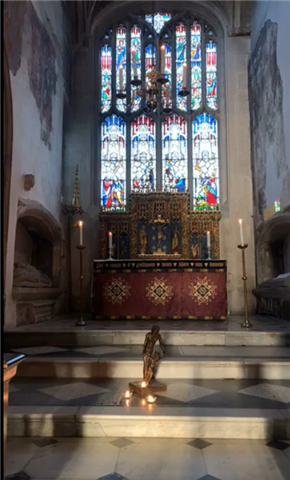
Since my visit to the church in February, when I gave a talk in which I spoke about my work and my hopes and aspirations for this commission, my thoughts about the project and what it means for me have continued to develop; in particular with regard to the way in which they have modified my views about the meaning of redemption. I therefore set them out here, and would be grateful if any of you reading this would e-mail me with your own thoughts with regard to any aspect of the project - particularly if you live in, or worship in Cirencester - and I will add them to this blog. My personal e-mail is rodneymunday@gmail.com.
Creation, Redemption, and the Incarnation.
For me, the Bible has two outstanding themes, that of Creation and that of Redemption; and it seems to me that they are brought together in the Incarnation.
As a sculptor, the idea of creation is of considerable importance to me. The story of the creation of Adam has been represented by artists countless times over the centuries because it is the prime symbol of the creative act. The Bible story represents a God who has an idea, a concept; but until the point where He actually makes a man in the physical world, man is not a reality. Once man is actually created, he takes on an existence outside his Creator. Only then can God communicate with him, because it is only then that man has a life (if disobedient) of his own. The story is a paradigm for every act of creation, whether of a child or a work of art. The point of creation is that it liberates the created from the creator. At that point, as E.M. Forster put it, the creator can look at his work “and wonder afterwards how he did it”; or as it is put in Genesis, God looked on what he had made “and saw that it was good. ” At which point, as Irving Stone said in his novel about Michelangelo, “every act of creation is an act of love.”
The meaning of redemption and its significance had long eluded me. I could not, and cannot, accept a belief in redemption in its traditional interpretation as a sacrificial substitute for man's sins. Firstly, as seen above, I do not accept the idea that the Creation story centres on man's sin in moving away from God's initial concept of him. God placed the two trees in the garden before he made man; and if he is omnipotent and omniscient, then he knew where those gifts of freedom would lead. “It is God who has made us, and not we ourselves” - so, as the Wurzles put it, “Don't blame I, blame 'e!” Secondly, I believe that the word “sacrifice” has taken on a significance that diminishes its literal meaning of “to make holy.” Because of primitive, superstitious, views about the need of placating the gods (as in the dreadful story of Abraham's willingness to kill his son), sacrifice has come to signify something which involves death in substitution or retribution, and it therefore has become diametrically opposed to its original meaning.
The etymological meaning of redemption is “to buy back.” This is frequently taken to mean God buying back his errant creation by sacrifice (in the diminished sense mentioned above). In every way, I find this unacceptable. I remember, many years ago, listening to a talk about redemption, in which the speaker produced a parable. He said that there was a master who was owed money by his servant, who was unable to pay his debt. The master, because he was both just and merciful, refused to forgo the debt, but gave the servant the money to pay him back. This was supposed to explain the reason for the crucifixion. It seemed to me then, as it seems to me now, to be the most atrocious excuse imaginable for the iniquities of a bureaucratic mind.
Redemption has to mean something very different, and the Cirencester commission has concentrated my thoughts by relating the Incarnation (symbolised by the combination of John the Baptist and the Virgin and Child) to ideas about creation which are an inevitable product of my own work.
It seems to me that the prime object of God's creation has been to give his creation freedom. He has then related to it. He has looked at it, and seen “that it is good.” He has come to love it, both as a product of himself, and as an existence separate from himself. The act of love binds the two and makes them inseparable though separate. The act of love therefore becomes a buying back. And that is redemption in the real meaning of the word. The Incarnation is the act of love in which the Creator steps back into the thing he has created. The crucifixion is therefore not a primitive act of retributive justice, but a direct expression of love, which at one and the same time accepts the freedom of that which is created, whilst bringing it to completion.
30th March
Since writing the above, I have heard from Duncan Forbes, who sent me the following, which refines and improves what I have said, particularly as it addresses the suffering of the crucifixion, which I had side-stepped :
I still find the crucifixion a puzzle. I myself can’t see it as a “direct expression of love”, rather as perhaps an inevitable consequence of the fundamental loving act of “stepping back into” the created order, an order which one way or another also has the capacity – which it has exercised – to “carve out” spaces where God is not, to allow and sometimes to promote what we call evil. One of the major changes in theological orthodoxy in the 20th century was a move away from the traditional insistence on the impassibility of God to the acceptance of a suffering God. Again, the church Fathers stood on their heads to try to explain how Christ the Son, the incarnate God, genuinely suffered on the cross, whilst God the Father remained unmoved and above it all. That won’t do any more. Unless the “whole of God” enters genuinely into human suffering and shares it with us in some way, then I can’t see how it can be claimed that “God is love”.
Further comments from Duncan about this project, and others as they arise, can be seen by clicking on the "Comments" link at the bottom of this page.
For more information about Project Blackjack, visit the church's website http://www.projectblackjack.org.uk or their facebook page https://www.facebook.com/CirenBlackJack.
Home
Public
Commissions Newsletter
Comments




